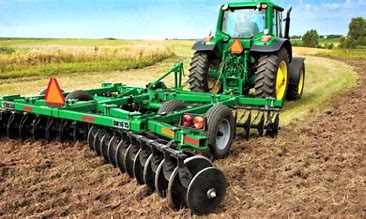Agriculture has always been at the heart of human
civilization, and the tools used to cultivate the land have evolved
tremendously over the centuries. Today, farm equipment plays a crucial role in
boosting agricultural productivity, making farming more efficient, and meeting
the growing demands of the global population. Lets explore the types of farm
equipment, their significance in modern agriculture.
The Role of Farm Equipment
Farm equipment encompasses a wide range of machines and
tools designed to assist farmers in planting, cultivating, irrigating,
harvesting, and transporting crops. These tools not only save time and labor
but also help increase yield, reduce crop damage, and make farming safer and
more sustainable.
Types of Farm Equipment
1. Tractors: The backbone of modern farming, tractors are
versatile machines that can be fitted with various attachments to perform
different tasks. They are primarily used for plowing, tilling, and hauling, but
their role extends to seeding, mowing, spraying, and even irrigation.
2. Plows: Historically, plows were among the first farm
implements used for turning the soil. Modern plows are often attached to
tractors and can perform tasks such as breaking up hard soil, aerating the
ground, and creating furrows for planting.
3. Harvesters: Harvesters are specialized machines that
automate the process of gathering crops. From combine harvesters used in grain
harvesting to potato harvesters, these machines reduce labor costs and speed up
the harvesting process, enabling farmers to process larger areas in shorter
timeframes.
. Seeders and Planters: These machines are designed to plant
seeds efficiently. Seeders sow seeds at the right depth and spacing, ensuring
optimal growth. Planters are more advanced machines capable of planting seeds,
fertilizing, and sometimes even applying pesticides simultaneously.
5. Irrigation Equipment: Irrigation is essential to farming,
especially in dry regions. Equipment like sprinkler systems, drip lines, and
center-pivot irrigation systems help ensure that crops receive the right amount
of water, enhancing their growth and conserving water.
6. Fertilizer and Pesticide Applicators: Proper application
of fertilizers and pesticides is critical for crop health. Applicators help
distribute the right amount of nutrients and chemicals efficiently, ensuring
minimal waste and maximum crop protection.
7. Post-Harvest Equipment: Once crops are harvested,
post-harvest equipment like threshers, dryers, and storage systems come into
play. These machines help process and preserve the crops, ensuring they reach
consumers in the best condition.
The Evolution of Farm Equipment
Farm equipment has come a long way from the simple tools
used in ancient agriculture. The earliest forms of farm equipment were
rudimentary, like hoes, sickles, and wooden plows. However, the Industrial
Revolution sparked a wave of innovation that revolutionized farming practices.
In the 19th century, the introduction of steam-powered
engines led to the creation of steam tractors, which were a precursor to the
modern internal combustion engines used in today's tractors. The 20th century
saw the mass production of machinery like combines, seeders, and irrigation
systems, which significantly improved efficiency and reduced the reliance on
manual labor.
Advances in technology, such as GPS systems, precision
farming, and automation, have further transformed farm equipment. Modern tractors
and harvesters are equipped with satellite navigation systems that help farmers
optimize their fieldwork, monitor soil conditions, and increase yield with
minimal environmental impact.
The Impact of Farm Equipment on Agriculture
The development and widespread adoption of farm equipment
have had a profound impact on agriculture, making it more productive,
efficient, and sustainable.
1. Increased Efficiency: Modern farm equipment can perform
tasks at a speed and precision that far exceeds what was possible with manual
labor. This efficiency allows farmers to work larger areas of land and produce
more food with fewer resources.
Advances in technology, such as GPS systems, precision
farming, and automation, have further transformed farm equipment. Modern
tractors and harvesters are equipped with satellite navigation systems that
help farmers optimize their fieldwork, monitor soil conditions, and increase
yield with minimal environmental impact.
The Impact of Farm Equipment on Agriculture
The development and widespread adoption of farm equipment
have had a profound impact on agriculture, making it more productive,
efficient, and sustainable.
1. Increased Efficiency: Modern farm equipment can perform
tasks at a speed and precision that far exceeds what was possible with manual
labor. This efficiency allows farmers to work larger areas of land and produce
more food with fewer resources.
2. Labor Savings: By automating many tasks that were once
done by hand, farm equipment has drastically reduced the need for manual labor.
This has not only improved productivity but also lowered the physical demands
of farming.
Improved Crop Yields: The precision with which modern farm
equipment can plant, irrigate, and apply fertilizers and pesticides has helped
increase crop yields while reducing waste. This has been crucial in feeding a
growing global population.
4. Sustainability: Advanced farm equipment has allowed for
more sustainable farming practices. Tractors and harvesters are now designed to
reduce soil compaction, minimize pesticide use, and optimize water use, which
helps preserve the environment.
Challenges and Future of Farm Equipment
Despite the numerous benefits, there are challenges
associated with farm equipment. The initial cost of purchasing and maintaining
modern machinery can be prohibitive for small-scale farmers. Additionally, the
environmental impact of large-scale mechanized farming, such as soil
degradation and reliance on fossil fuels, is a concern.
The future of farm equipment lies in further automation, smart technologies, and eco-friendly innovations. Electric-powered tractors, autonomous machinery, and the integration of artificial intelligence for precision farming are likely to play a significant role in shaping the next generation of farm equipment.




.jpg)









